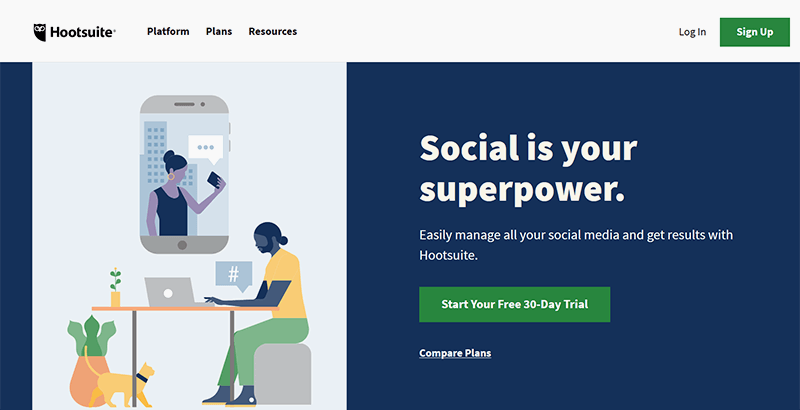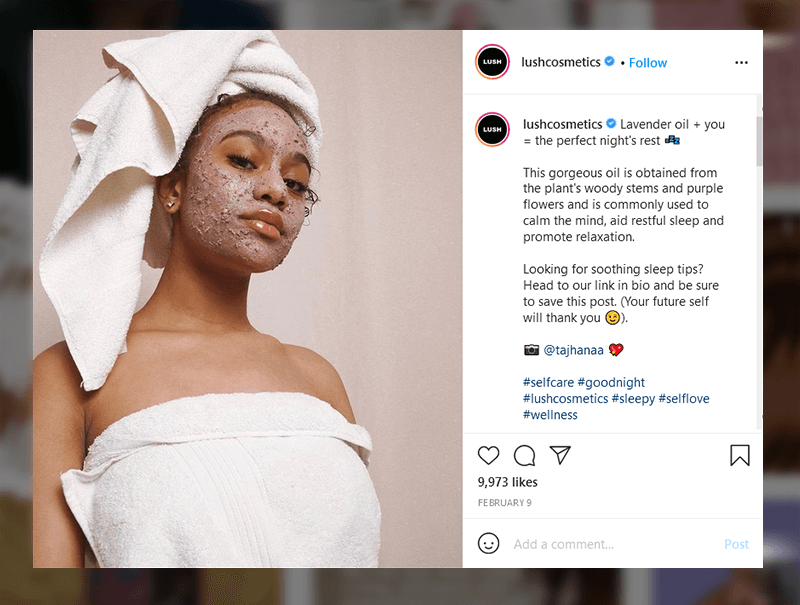NopCommerce Business Growth: 6 Social Media Trends To Jump On in 2021

Since the beginning of the year, we’ve published two articles dedicated to social commerce. We tackled Facebook Page Shops, Facebook Shops, and Facebook Marketplace. We also talked about Instagram Shopping and using the platform to its maximum potential in 2021.
Still hadn’t had a chance to read the guides? Do it now:
- 6+ Instagram Trends NopCommerce Merchants Should Look Out for in 2021
- Facebook Commerce in 2021: Еverything you need to know about selling on Facebook
Today’s article will focus on the six major social media trends you should consider in 2021.
What you'll learn
- How 2020 changed social media?
- Social media trend 1: People-first social media.
- Social media trend 2: Purpose-driven campaigns are on the rise. People prefer to shop from socially and environmentally conscious brands.
- Social media trend 3: Authenticity and transparency are the keys to creating successful social media content in 2021.
- Social media trend 4: Creating video content is essential. Live content is gaining popularity.
- Social media trend 5: Quality is more important than quantity.
- Social media trend 6: Social media platforms as customer support channels.
- Conclusion
How 2020 changed social media?
2020 changed everything from the way we live and work to how we communicate and shop. It even changed the way we use social media. More people started using social media and messaging apps to cope with isolation and being away from loved ones.
In 2020, over 3.6 billion people were using social media, and this number is projected to reach 4.41 billion in 2025. We also started spending more time on social media - the average person spent almost two and a half hours (144 minutes to be exact) on social media every day (source: Statista).
We turned to social media for comfort, support, and camaraderie. We started using it for a myriad of reasons, but mostly:
- To talk to our loved ones and share moments of our lives through photos, videos, and lives.
- To find inspiration, cheer ourselves up, and feel hope for the future.
- To shop and research products online (hence, the rise of social commerce).
- To stay on top of current events. However, this has had a major negative impact: since February 2020, social media has become a medium for conspiracy theories and digital misinformation. Now, more than ever, social media platforms are dedicated to the fight against fake news.
Stepping into 2021, brands need to adapt to the new normal. They need to consider all these factors as they have influenced the 2021 social media marketing trends. Next, we’ll have a closer look at each trend and show you how to make the most of it!
Social media trend 1: People-first social media
In 2020 social media became more human-centric - honest communication, fueled by compassion and a sense of community, took center stage. People turned to each other for support and inspiration.
In 2021, you’ll need to adapt your social media approach with this in mind - from your content and ads to the way you communicate with your customers (in the comments section or messaging apps).
What does this mean?
Essentially, this means that communication on social media today is a two-way street. If you want to be relevant, you can no longer afford just to put your message out there and hope for the best. 2021 is all about joining the conversation, i.e., talking with your customers rather than talking to them. If you want to be heard, you need to build a deep and meaningful connection with your audience.
How can you do this?
The key here is to listen - pay attention to how your customers communicate (in groups, posts, comments, etc.), what troubles them, what matters to them, what they need, how they feel, etc. This will allow you to refine your social media strategy, find your place in the narrative, and come up with the right ways to present your nopCommerce business on social media.
You can also find out what customers are saying about you or your competitors, stay on top of negative feedback and brand mentions, join conversations about your brand or products, аnd more. To achieve this, you need to incorporate social listening into your strategy, i.e., use social listening tools like Brand Mentions, HubSpot Social Media Management Software, Sprout Social, Hootsuite, Buffer, BuzzSumo, and more.

Social media trend 2: Purpose-driven campaigns are on the rise. People prefer to shop from socially and environmentally conscious brands.
Social causes have always been a part of social media - people have always been compassionate and driven by the desire to help. In 2020, due to the COVID-19 pandemic, this was heightened - people wanted to do more.
This is why 2021 will be all about inclusivity and purpose-driven campaigns. Now more than ever, people want to help each other and to invest in brands that wish to make the world a better place - either by contributing to a social cause or reducing their environmental footprint.
74% of consumers want brands to showcase acts of kindness. 77% feel more positively about brands that support society in times of crisis (source: Twitter survey).

What does this mean?
If you want to build customer trust and loyalty, you can’t be silent about the issues and causes your target audience cares about. But this shouldn’t be only on a marketing level. You should genuinely support and actively contribute to the initiatives you choose.
Depending on your business and what you offer, the topics your customers will be passionate about may differ - from mental health to social justice or sustainability.
To stay relevant in 2021, you need to talk about these topics in an honest manner. You need to show your support - be it through participating in an initiative, investing in an organization, or shifting towards a more sustainable future by choosing recyclable packaging, local sourcing, fair trade, and more.
Basically, your goal is to make your voice heard - talk about your values, mission, and goals. Then, become a part of initiatives that represent them. This will help your customers feel more connected to your brand. It will also build brand loyalty as people want to shop from brands that share their values and contribute to causes they care about.
Social media trend 3: Authenticity and transparency are the keys to creating successful social media content in 2021.
As we mentioned, 2020 turned social media into a medium for conspiracy theories and digital misinformation. All platforms put efforts towards silencing fake news. As a result, in 2021, authenticity and transparency will be paramount.
What does this mean?
You need to connect with your customers on an honest and human level. Personality is key. Customers need to feel they’re talking to real people - they want to know who stands behind the brand and what drives them. They want to recognize the brand’s views and values as their own. They want to know what goes into the process of creating a product, who stands on the other side of the customer support line, how the backstage of a photoshoot looks, etc. They need to have access to honest customer feedback and testimonials.
Leveraging social media is a great way to achieve all this and build meaningful connections with your customers. Here’s how:
- Post honest and unfiltered content. Your team is exhausted after a successful sales campaign? Post a photo of their tired, happy faces with a heartfelt copy: “We worked for 12 hours straight, but it was absolutely worth it! 300 orders packed and shipped! Thank you guys, you’re amazing!” Something went wrong during a photoshoot? Say, the model spilled coffee on a white silk shirt. No problem - when life gives you lemons... Just take a series of fun photos and post them on Instagram with a relevant hashtag.
- Maintain transparency about your products, services, and operations. For example, if you need to take a product off the market for any reason, explain why. If there is something wrong with the product, write a formal apology and post it on social media. Owning up to a mistake can go a long way - if you do it right, you’ll acquire new customers instead of losing existing ones.
- Host lives. Dedicate a time of the week when customers can reach out to you with their questions. Different members of your team can host the Q&A sessions each week. This is a great way to show your brand’s personality - customers can literally see who stands behind the products they use or wish to purchase.
- Share fun GIFs or memes describing everyday situations if, of course, this matches your brand vision and voice.
- Encourage your customers to reach out with any issues regarding your products, brand, services, etc. Encourage them to share honest feedback - from what made them happy to the smallest detail that brought disappointment.
- Respond to all comments and messages promptly. Speak in a friendly manner, yet, keep things professional. After all, you’re running a business - customers should like you, but they should also feel they’re in good hands.
- Repost all feedback - sharing negative feedback can benefit your bottom line just as much as positive feedback. The key here is to respond and act accordingly, making sure everything's out in the open. This will show potential customers that you stand behind your products and are willing to take responsibility if something goes sideways.
As you can see, you can do a number of small things to prove that your brand is authentic and trustworthy. It happens every day, step by step, post after post… but the long-term effect of your short-term efforts will be tremendous.
Sidenote
The consumers’ need for authenticity has lead to two sub-trends:
- The continuous rise of niche influencer marketing
- The increased use of user-generated content (UGC) in marketing campaigns
The rise of niche influencer marketing
In 2021, influencer marketing is still as strong as ever. But there is a little shift in the trend - since people seek authenticity and want to connect with businesses and people who share their values and personal views, brands will be more focused on collaborating with niche influencers, instead of macro or mega influencers. Besides, they’ll seek to build meaningful and long-lasting partnerships with these influencers, instead of working with them on a post-to-post basis.
Why niche influencers?
Each influencer tier communicates differently with their audience. Niche influencers are more open, honest, and human than macro and mega influencers (Hollywood celebrities, social media celebrities, etc.). Their audience typically shares their values. Also, because they can connect with their followers on a more personal level (and even engage in one-on-one conversations), niche influencers are seen as more trustworthy, relatable, and authentic.
Basically, if you collaborate with the right niche influencers, your message will resonate with their audience, and you’ll achieve outstanding success. This is because niche influencers usually have higher engagement rates and ROI (especially in the long-term).
So, to build a successful influencer marketing strategy in 2021, you need to work with influencers who:
- Are genuine, authentic, considerate, and relevant.
- Share your brand values.
- Have a recognizable voice and post with purpose. Make sure to work with influencers whose voice matches your brand voice because they can tell your brand story (and promote your products) in a way your target audience relates to.
- Tell stories and write more personal, long-form captions. This establishes a stronger emotional connection between the influencer and their audience. If your brand is a part of such a genuine narrative, people would naturally feel they can trust you. As a result, they will not only buy from you, but also recommend you to their family and friends, or share a link or two to your website on their own social media profiles.
- Are using products similar to yours - their followers are more likely to become customers as well.
- Have good engagement rates, high activity levels, high social and website authority, and more - you can use a tool like Whalar, BuzzSumo and BuzzStream to get this information and shortlist the most promising prospects.
Remember, your goal is to build meaningful partnerships that bring long-term value. Don’t go about it thinking: “Let’s just see if this influencer can help me clear out the stocks of that product that didn’t sell very well last season.” Instead, think of how collaborating with an influencer can bring continuous value and mutual benefits to both sides. A good way to achieve this is to start an affiliate program and turn the influencers you collaborate with into brand ambassadors.
A brand ambassador is someone (an influencer, a celebrity, a customer, an employee, etc.) who has signed a long-term contract with a business to help them increase brand awareness, gain new customers, make more sales, etc. Brand ambassadors officially represent the brand and everything associated with it (including values, products, services, lifestyle, and more).
Brand ambassadors promote your business, brand, products/service, etc. repeatedly over the course of several months or years. And, since they use your products, the content they create is seen as more authentic and trustworthy.
You see our point - the consumers’ desire for authentic and trustworthy content has led brands to seek collaborations with niche influencers their audience finds relevant. Going forward, more and more brands will jump on this trend and prefer to work with several niche influencers instead of one macro or mega influencer.
The increased use of user-generated content (UGC) in marketing campaigns
The need for authenticity has also led brands to reconsider the way they advertise their products. In 2021, a UGC photo is much more effective than a polished professional product photo; a video testimonial is more valuable than a promotional product video or a product explainer video. This is because UGC content is generally seen as more genuine than branded content. As a result, people (especially potential customers) are more likely to trust UGC ads (i.e., ads that contain images or videos created by customers, not by brands). You can think of it as an extension of the consumers’ need to communicate with brands - such ads make them feel like they’re a part of a conversation, i.e., that a brand’s narrative isn’t one-sided.
Ultimately, UGC raises engagement rates, boosts credibility, builds brand loyalty, helps you build a recognizable brand presence online, and can tremendously benefit your bottom line. This is why more brands are expected to leverage UGC in 2021.
There are many ways to encourage UGC - giveaways are one of the most popular choices. You can also run contests, leverage the power of hashtags, and more. It really won’t be that difficult because your customers already create social media content every day. Plus, there are so many ways to have fun while creating UGC - Instagram filters, reels, and TikTok remixing are just a few examples of the ways customers can create content for their favorite brands.

Source: Instagram, lushcosmetics
The takeaway
Overall, if you want to cut through the noise on social media in 2021 you need to post authentic and trustworthy content. The key to building an authentic brand presence online is to invest in valuable relationships with your employees, customers, and relevant niche influencers. Remember that the voices of real people are what your audience values most.
Social media trend 4: Creating video content is essential. Live content is gaining popularity.

By 2022, 82% of all online content will be video content (source: Cisco). And did you know that social video generates 1200% more shares than text and images combined (G2 Learning Hub)? In fact, 92% of mobile video viewers share videos with others (Social Media Week).
All this proves that video content is not only here to stay but is also on the rise. To help businesses make the most of it, social media giants like Instagram have announced new ways to help brands profit from video content - from IGTV ads and live video streaming to changing the algorithm to prioritize video content over other forms of visual content.
In addition, 2020 saw an uptick in the use of live streaming. As a result, in 2021, more brands are expected to use live streaming to connect with their customers. This is because people find connecting with brands in real-time extremely enticing - 40% of consumers want to see more interactive live content from brands (source: Sprout Social Index). Why? Because lives are fun, interactive, and interesting. But, most importantly, they are raw and authentic.
So, to stay relevant in 2021, you need to start creating video content. To achieve even more outstanding results, you need to host lives. You can host Q&A sessions, product launch announcements, take your customers behind the scenes showing them your office, shipping station, the location of a photoshoot, etc. You can also host lives with the influencers you collaborate with, other brands you partner with, and even your customers.
Social media trend 5: Quality is more important than quantity.
This isn’t exactly a new trend. In fact, it is common sense and you’ve probably been following this advice for years.
However, we believe that this is the perfect moment for a reminder - in terms of content, quality always wins over quantity.
So, in 2021, don’t focus on posting just any content on social media. Focus on posting helpful and meaningful content. Such content is more difficult and time-consuming to produce. This means that you may not be able to post as frequently. But that’s okay - in 2021, people care more about the quality of your content, rather than the number of posts you manage to get out there weekly. As a result, high-quality content performs much better.
Here are a few examples of in-depth content:
- Informative text posts that add value (e.g., solve a problem, answer a question, explain the process behind creating a product, etc.). The best practice is to create snackable content as it is more shareable, has higher engagement rates, and performs better overall.
- Podcasts in which you address your customers’ issues or talk about your products in an open and honest manner.
- Video testimonials.
- Product explainer videos or posts dedicated to specific products (i.e., their features and benefits).
- UGC, such as product photos, videos, reels, stories, product reviews, honest feedback, etc.
- Posts dedicated to your brand story, vision, mission, and values. If you write about your values, don’t create a bullet list post. Instead, write a story that incorporates your values - this will resonate with your customers on a deeper level. It will also show your brand has a personality.
- Interviews with relevant influencers, partners, and customers.
Basically, the sky’s the limit! And there’s just one rule of thumb - don’t be afraid to put your brand out there! Test different types of content and see which content performs best, i.e., what resonates with your customers.
Social media trend 6: Social media platforms as customer support channels.

In 2020, more people started using social media as a customer service channel - it was a fast, convenient, and efficient way to get in touch with brands and receive quick answers and support. Besides, receiving support directly on social media has always made people more confident about brands. As a result, more brands started putting efforts towards improving their social media customer support.
This will continue to be the case in 2021. So, you should definitely consider offering customer support on social media (i.e., via messaging apps like Facebook Messenger and WhatsApp). You can allocate more resources, such as hiring new support team staff members or use a chatbot. Then, once you have everything in order, you can create posts announcing that you offer support on social media, so that everyone knows they can reach out to you whenever they need. Remember, if you don’t offer 24/7 support, make sure to clearly state when support is available, e.g., Monday - Friday 9 a.m. - 6 p.m. This is the perfect way to avoid confusion and save yourself the trouble of unhappy customers.
Conclusion
We hope this guide gives you a better understanding of the 2021 social media trends and how you can leverage them for your business.
To wrap things up, here are some of the most important things to remember about each trend:
- In 2020 social media became more human-centric. In 2021, consumers expect brands to engage them in a meaningful and honest conversation.
- Purpose-driven campaigns are on the rise. In 2021 people want to help each other and invest in brands that make the world a better place - either by contributing to a social cause or reducing their environmental footprint.
- 2020 saw a rise of digital misinformation on social media. All platforms put efforts towards silencing fake news. As a result, in 2021 brands are expected to be truthful, authentic, and transparent.
- Live content saw an uptick in 2020 - people got used to communicating through lives. In 2021, they also expect brands to produce more live content. As a result, more brands are expected to jump on the trend.
- In 2021, people care more about the quality of the content you post on social media, rather than the number of times you post weekly.
- In 2020 more people started using social media as a customer service channel. As a result, brands gradually started putting efforts towards offering support on social media.
If you have further questions, just leave a comment below!




